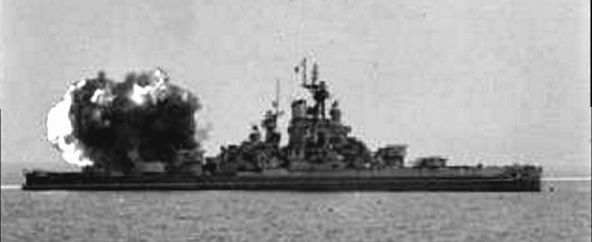Authors:
Historic Era: Era 9: Postwar United States (1945 to early 1970s)
Historic Theme:
Subject:
June 2021 | Volume 66, Issue 4


Authors:
Historic Era: Era 9: Postwar United States (1945 to early 1970s)
Historic Theme:
Subject:
June 2021 | Volume 66, Issue 4
Editor's Note: Don't miss the first half of this essay, Two Hours in Hell at Pearl Harbor. Author Ed Offley, after serving in the Navy during Vietnam, reported on Naval issues for three decades for The Ledger-Star in Norfolk and The Seattle Post-Intelligencer. He was also Editor-in-Chief of DefenseWatch Magazine. Mr. Offley has written five books, including a favorite of ours, Scorpion Down: Sunk by the Soviets, Buried by the Pentagon. This is the second of a two-part essay on the dramatic history of the battleship USS Nevada (BB-36), which survived the Japanese attack on Pearl Harbor and went on to serve in the Aleutians, Atlantic convoy escort duty, the Allied liberation of Normandy and southern France, and the climactic battles of Iwo Jima and Okinawa.

The mammoth warship steamed in darkness toward a new baptism of fire, its crew at General Quarters.
It was the early morning of D-Day, June 6, 1944. The aging battleship USS Nevada was heading for the coast of France to provide gunfire support for two of the American landing beaches at Normandy. In several hours, the U.S. Army’s 4th Infantry Division would go ashore at Utah Beach, aiming to link up with paratroopers from the 101st Airborne Division already dropped behind the German lines. Designated targets for Nevada and her two accompanying cruisers included 110 German artillery pieces spread throughout the inland area, as well as a twelve-foot concrete seawall. Their destruction was vital if the American soldiers were to survive and move inland.
Read the first part of this essay, Two Hours in Hell at Pearl Harbor, by Ed Offley
Few in the U.S. Navy would have imagined this scene thirty months before. During the deadly attack on Pearl Harbor, the Nevada was the only battleship able to get under way. She had been a dramatic sight as she steamed out from the smoke and flames. But then Japanese planes focused their deadly attack on Nevada, and she was soon broken and sinking near the harbor entrance.
Now the battleship was primed for combat halfway around the globe from where it had rested on December 7, 1941. She had already seen action against the Japanese in the Aleutians, but the test that her captain and crew now faced was far more deadly.
and torpedoes, and temporarily beached on Hospital Point to keep her from sinking too deep. National Archives." data-entity-type="file" data-entity-uuid="55c042b1-5bfb-41df-a7c0-a447a3cb361d" src="https://www.americanheritage.com/sites/default/files/inline-images/USS_Nevada_temporarily_beached_on_hospital_point_925AM_NARA-80-G-19940%20%282%29_0.jpg" width="1024" height="581" loading="lazy">
THE INITIAL assessment of damage to the Nevada after Pearl Harbor had been somber: Salvage crews and Navy divers inspecting the beached ship at Wapio Point in the days after confirmed that its hull was breached in two locations on the port bow where a torpedo had struck, and where a bomb from the second attack wave had caused a second immense hole. The entire forward part of the ship below decks had been gutted by fire, and the superstructure was likewise a shattered, burnt-out ruin.
All but 300 of Nevada’s crew were hastily reassigned to other ships as a salvage team began a herculean effort to patch up the hull and get the battleship refloated.
Working around the clock, shipwrights at Pearl Harbor Naval Shipyard constructed massive patches to close the gaping holes in her hull. Eight weeks after the attack Nevada rose off the harbor seabed. Towed to Drydock 2, she received more rugged hull patches, replacement machinery and equipment during a sixty-five-day refit.
On April 22, 1942, a skeleton crew got the ship underway for Puget Sound Naval Shipyard in Washington state, where Nevada underwent a major modernization that transformed her silhouette and significantly increased her combat power. The two tripod masts – long a defining feature on American battleships – were removed, replaced by a single foremast. A large SK-2 air-defense radar atop the new mast replaced the previous manned fire control stations.
That new technology was part of a major upgrade to the ship’s anti-aircraft capability: Its old 5”/25-cal. AA guns and 5”/51-cal. secondary guns were removed and replaced by sixteen powerful 5”/38-cal. guns mounted in twin turrets, eight to a side. Eight quad-barrel 40-mm Bofors anti-aircraft guns and forty 20-mm. Oerlikon automatic cannons further increased the ship’s formidable defenses against air attack.
Since each of the 5”/38-cal. guns took about fifteen sailors to operate, and each gun had four complete teams standing rotating watches, the new secondary battery and Bofors/Oerlikon stations added more than 800 additional sailors to the crew, raising it from 1400 to over 2220 officers and men.
The Nevada’s original mission had been to fight as part of a fleet of battleships against an enemy force comprised of the same massive gunnery ships. Two factors transformed the ship’s combat role: the advent of carrier air power as the U.S. Navy’s predominant striking arm, and a